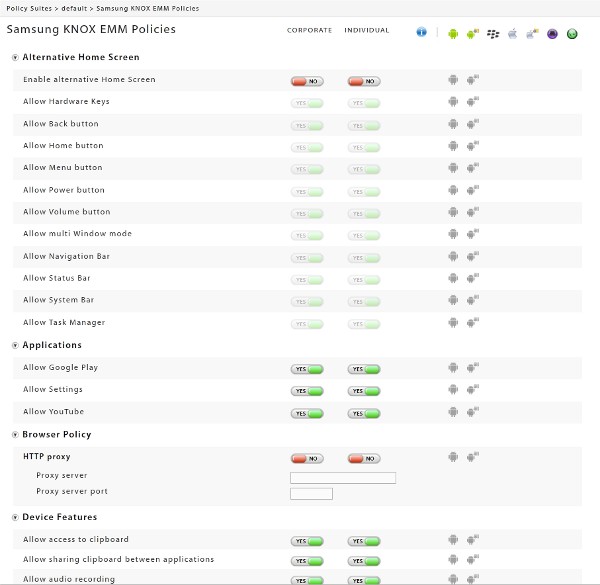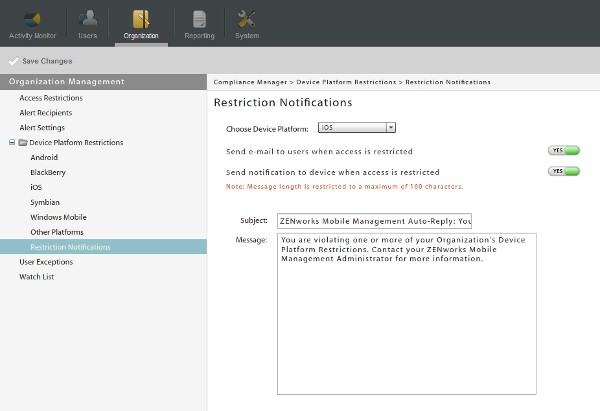The Novell team just released ZENworks Mobile Management 3.0.1, building on the great capabilities introduced in version 3.0. Some of the cool new features include improved device control and policy management for iOS and Android devices, which increase user productivity while maintaining high data security. Here are the details of what ZENworks Mobile Management 3.0.1 offers.
Samsung KNOX Support
Support for Samsung KNOX began with ZENworks Mobile Management 2.9.1. This powerful technology allows you to apply additional policies to Samsung devices that are KNOX-enabled. ZENworks Mobile Management 3.0.1 leverages KNOX platform capabilities so you can:
- Enforce common restrictions such as limiting the device to single app mode and displaying the play store
- Enforce a whitelist or blacklist of applications to prevent users from installing unwanted applications on the device
- Provision the KNOX Container so that enterprise applications and email can be separated from the user’s main device (requires the purchase of a KNOX Workspace license from Samsung)
- Automatically configure email for either the native Samsung email client or the KNOX Workspace email client
- Distribute corporate applications to the KNOX Workspace Container
- Get additional details about the device including the user configured name, Bluetooth and wireless MAC addresses

iOS Improvements
ZENworks Mobile Management 3.0.1 also provides expanded compatibility with iOS, including:
- Support for the Apple Device Enrollment Program (DEP)–DEP requires devices purchased directly from Apple to enroll with ZENworks Mobile Management during setup. It also facilitates over the air supervision, which eliminates the need to connect the device via USB and use iOS configurator. You can also use
- ZENworks Mobile Management to name the iOS device.
- Distribution of the ZENworks Mobile Management app as a managed application–With ZENworks Mobile Management 3.0.1, you can deploy the management app itself as a managed application for devices enrolled by DEP or iOS configurator.
- iOS 8 restrictions. Administrators can prevent the user from wiping his or her device and accessing other iOS 8 features.
- Installation of applications from ZENworks Mobile Management only—This feature allows administrators to disable direct end-user access to the app store, while still distributing recommended and assigned applications from either the app store or your own corporate applications.

Push Notification Enhancements
In response to customer demand, ZENworks Mobile Management 3.0.1 allows users to send notifications to devices using Apple and Google push notification services.
Instead of sending emails and SMS messages, users can now leverage the built-in capabilities of the mobile device platform.
With push notifications, you can send admin-specific messages using either a device- or group messaging option.
Used together, push notifications and Novell® Compliance Manager can send notifications when a restricted action occurs.
It is important to note that on iOS, ZENworks Mobile Management leverages the Novell Push Notification Service (NPNS) to enable secure communication between the devices in your zone and your server.

Other Key Enhancements
ZENworks Mobile Management 3.0.1 also includes enhancements that improve day-to-day use, including:
- An acceptable use policy that the user must accept when they enroll a device
- Support for SAML authentication during enrollment, allowing the user to easily use a single sign-on system
- Use of LDAP variables as part of corporate resource definitions and assignments so that when you configure resources, you can have different formats for each resource
- Custom device fields in addition to existing custom user fields, allowing you to store the user or device information that you need
Conclusion
This recent release continues our drive to make ZENworks Mobile Management a crucial component of mobile device management, providing customers with the tools they need to ensure user productivity and to keep their sensitive data safe.
(This article was published in OHM28, 1-2015, p25-26).

